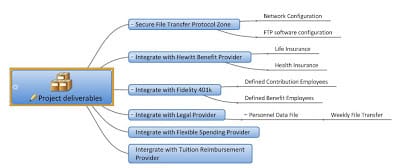In project management, a project scope statement is a useful tool to outline the project’s deliverables and identify the constraints, assumptions and key success factors of a project.
The scope statement defines the boundaries of this project. However, prior to getting the project underway, the project team and its stakeholders need to agree to the scope statement before its execution.
The scope of a project has an impact on two specific elements of the project – its time and resources. If your team can’t agree to the scope, the other two elements will be ever-changing despite your best intentions to make the project a success.
As the project manager, it’s easy to often refer to the project scope statement as the formal documentation as the accepted project scope. Some project scope statements run the risk of exceeding an academic dissertation, when in reality only a page was needed to convey the relevant information. The sign of a good project manager? To know that the scope will adjust across the project lifecycle, and recognize that compiling a tedious scope volume isn’t the best use of the team’s time or your own.
There is a better solution. You can document the scope statement using a mind map. Using a mind map means you can still contain the key elements of a project scope statement while also keeping the information brief and most importantly, engaging.
Here are the 6 main ways to develop a Project Scope Statement with MindGenius.
- Project scope description – a brief description or summary on the project.
- Project deliverables – the specific list of results produced by the project.
- User acceptance criteria – a list of critical success factors to accept the project deliverables.
- Project boundaries – identifies what deliverables are in an outside of the project’s scope.
- Project constraints – a list of project limitations typically categorized by results, time frames, resources, physical or technical constraints
- Project assumptions – a list of thoughts that are believed to be true yet need to be confirmed.
Figure 1 (below) displays the MindGenius scope statement template.

When you are developing a project’s scope, the list of deliverables, constraints, boundaries, and assumptions is often the result of brainstorming. Using a mind map to capture an exhaustive list of deliverables and the refining them provides flexibility in the scope definition process. Once you have reviewed these ideas, the formal scope statement can be refined for presentation.
How will you document the scope?
By using MindGenius to easily facilitate the meetings, you can capture all the project scope details as the business customers brainstorm deliverables, constraints, assumptions and acceptance criteria.
Using our Map Explorer feature, you can focus on specific project deliverables without displaying other sections of the mind map (Figure 2, below).

Once you’ve agreed on deliverables, the mind map can be refined and the branches can be collapsed. MindGenius helps to organize the different parts of the scope statement to communicate a view that is easy to understand for everyone in the team.
Stakeholders don’t want to read more than a page describing the project scope. Most project deliverables (scope statements, charters, and requirements) are converted into a PowerPoint presentation for executives. This is where we come in. MindGenius helps reduce the administrative burden by exporting to Microsoft PowerPoint or Microsoft Word. The visual format of the MindGenius mind map helps to convey the project scope without having to read pages of documentation.
I’ve conducted numerous brainstorming sessions to develop a project’s scope and using mind maps is an excellent way to plan, prioritize and communicate using colors, picture and lines to identify important ideas and key questions. Figure 3 (below) includes the completed mind map example.

You can use similar mind map formats for other project management related issues, such as project charters, communication plans, work breakdown structures and meeting minutes. Meeting minutes are often an administrative bore, yet by creating meeting minutes in a visual mind map format, I’ve found it keeps team members more engaged. The mind map acts as the meeting agenda and the meeting minutes are created real-time as the project manager appends notes to each of the agenda nodes. Instead of creating separate document, I create a PDF of the mind map and send it to the team after the meeting.
Meeting minutes and scope statements are just two examples of the project deliverables that can be created using MindGenius. The visual aspect of the product helps your team understand complex problems easier. Stakeholders like the visual communication because pictures simplify the overall scope, challenges, and successes of the project. I find stakeholders, PMOs and executives are always looking for better visual dashboards. Mind maps are an excellent solution to add to any executive reporting deck due to their visual nature.
In stakeholder reviews, I’ve used visual mapping to create more engagement and discussion instead of the typical bullet points that are glazed over and hardly read. The graphical nature of the mind map further enables discussion as project stakeholders discuss challenges, reprioritize requirements and continue to refine the mind map.
Overall, when you are deciding to start a project and discuss the project scope and what it entails, there is no better way than to start with a mind map; a MindGenius one.
You can Get Started with MindGenius by clicking here. No credit card? No problem. It’s FREE.

